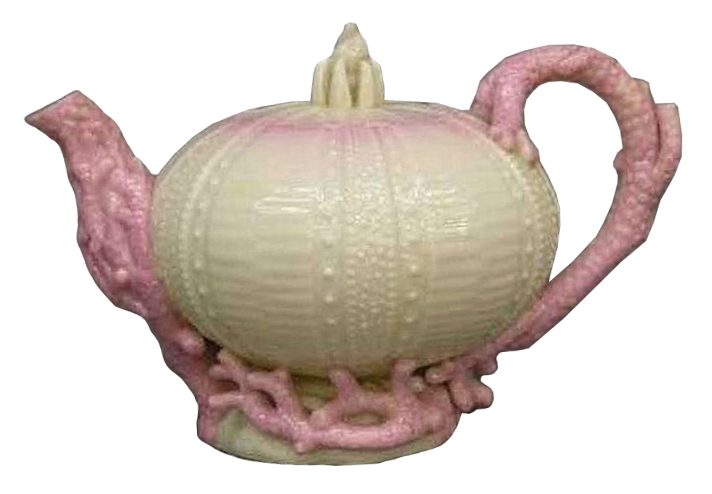
At the height of the Great Irish Famine, John Caldwell Bloomfield, an amateur mineralogist, inherited an estate which encompassed Belleek, a village in County Fermanagh (today Northern Ireland). Devastated by the distress he witnessed, the young man vowed to return the village to prosperity. As luck would have it, his land held abundant amounts of raw materials required to produce ceramics. So true to his word, in 1857, Bloomfield founded the Belleek Pottery.
Initially, his company molded hard-wearing earthenware items like milk pans, pudding bowls, feeding cups, footbaths, and wash basin sets. Shortly after, the pottery also began producing translucent, eggshell-thin porcelain, perhaps the finest ever made. Their serving plates, muffineers (sugar shakers), trinket boxes and tea sets, for example, gained immediate popularity. Because all vintage Belleeks, were handcrafted, no two were exactly alike. Each was a work of art.
Belleek’s unique marking system, which reflects changes in company ownership or international import law, makes most pieces fairly easy to date. The earliest ones, whose trademarks depict Irish wolfhounds, round towers and Irish harps, are the most collectible of all. These are commonly divided into First (1863-1891), Second (1891-1926), and Third (1926-1946) Black Mark periods. Because these delicate pieces are so fragile, discovering any at auction is remarkable. Moreover, because they are finite, they hold or increase in value.
Modern Belleeks, which bear green, blue, gold or black marks dating from 1946 on, are generally appreciated for their decorative value alone. Yet some, like complete, mid-20th century tea sets, are becoming increasingly scarce.

Pieces that passed through production unmarked, or whose marks have worn away, can often be identified by their raised patterns. Several, like crisscrossed Rathmore and ribbed Finner, for example, immortalize Belleek’s neighboring hamlets. Thistle, Daisy, Thorn and Grass evoke its rural landscape. Limpet (marine mollusks), Tridacna (saltwater clams) and Echinus (sea urchins) patterns, gleaming with pearly seashell-like lusters, reflect Belleek’s proximity to the sea. In addition, beloved Irish shamrocks adorn everything from salt and pepper shakers and honey pots to traditional Celtic Patrick’s crosses.
Since British afternoon teas had long been fashionable, Belleek also produced scores of teapots. Many, though classic in style, feature dramatic rainbow-striped, twisted, angular or spiky, twig-like handles. Others bear amorphic, knobby, coral-like creations, sometimes in startling shades.
A particularly rare teapot, the finely decorated First Black Mark “Grass Tea Ware” held by London’s Victoria & Albert Museum, contains a teatime cautionary tale, literally. The printed underside of its lid reads: “Fill with water blood warm and allow it to stand a few minutes empty and [then] use with boiling water.” Apparently, this practice deterred ceramic thermal shock.

Belleek tea pots boasting China-inspired dragon-shaped spouts, or plates portraying writhing dragons, are also quite collectible. So are marble-like Parian busts and figurines, fashioned from unglazed bisque porcelain. Unusual Parians, like Third Black Mark spill vases, which stored rolled tapers to transfer fireside flame to lamps, however, hold special appeal.

Belleek’s hand-braided porcelain baskets, created in varied shapes, are also charmers. In addition to fragile latticework, many bear amazingly detailed porcelain bouquets in tender shades of butterscotch, spring-green, blue, and pink. Since these basket-surfaces are so richly adorned, however, most bear narrow, identifying banners rather than Belleek marks. Yet to some extent, they can also be dated by the complexity of their braiding. Baskets fashioned from three-strand braids were produced before 1921; four-strand ones appeared later. Regardless of their age, any that survived free of cracks, chips, flakes, scratches or repairs are exceptional.

Though Irish Belleeks reached fashionable American china shops in the 1870s, they roused general interest. In response, a handful of local firms, like the Willets Manufacturing Co., based in mineral-rich Trenton, New Jersey, created fine porcelain that rivaled its European counterpart. Though their American Belleeks, as they are known, resembled their namesakes, they were made entirely from local materials. Some were factory-decorated; others were sold as white, paint-it-yourself projects.

A decade later, Walter Scott Lenox, a Trenton ceramics designer and decorator, together with a co-worker at the Ott and Brewer Co., founded the Ceramic Art Co. It quickly gained fame for superbly designed, exquisitely painted American Belleeks. On acquiring sole ownership of the company in 1896, Lenox added “Lenox” to their trademark. Despite remarkable success, the Lenox-Belleek line was discontinued in 1906, in favor of Lenox dinnerware.
American Belleeks typically feature eclectic styles ranging from Romantic and Rococo to Art Nouveau—sometimes in a single piece. In addition, their bold, enamel figural and naturalistic images are often extravagantly gilded and glazed.
Some collectors prefer these exuberant, all-American porcelains. Others consider classic, exceptionally designed Irish Belleeks far more appealing.



